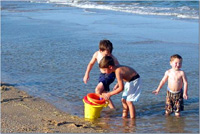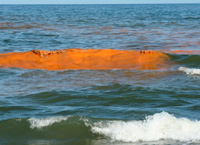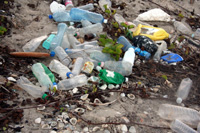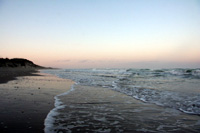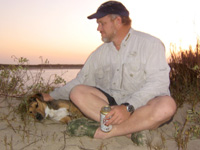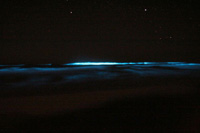Getting
Out There: |
Directory of all "Getting Out There" Articles> |
|
Page
1
| 2
|
| On an off-road trek along the Gulf of Mexico in southernmost Texas, Aaron Reed encounters many memories and a mystery. The memories are familiar -- fishing with his grandparents, nursing the injuries of a misspent youth -- but what is that orange stuff out in the water? |
|
[Continued from page 1]
The southern tip of the island
We continue down the beach, finally reaching the Mansfield Channel jetties. The channel, also called "East Cut" locally, was dredged in the 1950s. It cut Padre Island in two and created South Padre Island, best known as a college Spring Break destination. The Mansfield dredges also dug right through the submerged wreck of the Santa María de Yciar, one of three Spanish ships that sank in a fierce storm here in 1554.
Perhaps as many as 300 mariners and passengers survived the storm. A small contingent of skilled sailors set sail for Veracruz in a small boat to notify officials and organize a salvage party. The rest set out on foot, heading south for settlements in what is now northern Mexico. The trek toward civilization turned into a death march as the survivors confronted hostile natives and an equally hostile environment. Only one, Fray Marcos de Mena, made it to Panuco.
A salvage expedition was already in the works, and the Spaniards recovered about half the cargo from the three ships. More than 400 years later, a private salvage company based in Indiana got some of the rest of the cargo before having it wrested away by the state of Texas. Many of the artifacts - including gold bullion and silver coins -- are now on display at the Corpus Christi Museum of Science and History, along with an account of the doomed voyage. Sand-encrusted coins still sometimes wash up on the shore here, especially after storms. It is illegal to remove such artifacts from the park, but I can say from experience that the mere possibility of finding a genuine Spanish real is a powerful stimulant to a young boy's mind.
Today there are no coins. Tamara and I cast our lures from the rocks of the north jetty, but fishing is slow, so we follow a trail through the dunes and marvel at the blooming wildflowers: Indian blanket (gaillardia) and sunflowers and Texas lantana, varieties that farther north in the state have packed it in for the winter.
A couple of trucks pull up at the end of the beach -- one fellow is driving a two-wheel-drive pickup, the other a four-wheel-drive truck -- just in case, I guess.
"How'd y'all get that little car down here?" the four-wheel-drive occupant asks us as he stares at Tamara's Subaru Baja in amazement.
I couldn't resist: "We drove it."
More mysterious still
I climb a sand dune and call my brother to update him on our progress. I know from previous visits that the high ground at the end of the island is the only place one can reliably make or receive a mobile call. Cell towers in the fishing village of Port Mansfield, about 10 miles across the bay to the west, are just close enough to provide service.
"Listen, we're going to try to get through the bad area before high tide," I tell John. "If you don't hear from us by 10:30 or 11, we'll be stuck somewhere between the 15- and 25-mile markers."
I tell him about the weird orange stuff in the surf.
John is our safety net. Sailors and paddlers file "float plans." We had filed a "drive plan," and knew we could rely on John to come pull us out with his big four-wheel-drive truck if we got stuck.
Heading north now, I'm driving faster, trying to beat the high tide. Winter tides, especially when there are three or four in a day, are not particularly large, but still ….
It's dark now, and - again - Tamara is the first to see it.
"Are those waves glowing?" she asks.
I answer with all the confidence of my experience on the island: "I'm pretty sure it's just the moonlight."
But I slow the car, and then -- just ahead -- I see an explosion of intense blue light in the surf. It fans out like lightning: a fierce, liquid line racing across the face of a breaking wave, subsiding into a neon glow as the wave foams up on an offshore sandbar.
There: another. And another. I am transfixed. The surf is popping with lights. It's like a Fourth of July fireworks show. It's like an approaching thunderstorm. It's like …. nothing I've ever seen before.
"Lights crackle, waves crash," Tamara says, under her breath.
It is an achingly beautiful sight.
We get back into the car and drive slowly north, looking for a place to tuck the vehicle into a fold in the dune line and perhaps build a driftwood fire and continue to watch the show.
Headlights appear in the north. Something big, moving fast, jouncing across the uneven beach. We pass, and the other vehicle slews around in a spray of sand and pulls alongside. I glance over, concerned, and see my sister-in-law waving from the passenger window.
"John got off early," she shouts over the sound of the waves. We pull up next to the water and attempt to photograph the amazing light show.
With night, temperatures have plunged into the 40s. We huddle behind Tamara's car, watching in silence as the minutes stretch into half an hour or more.
My brother turns toward me.
"This," he says softly, "was worth the trip down here all by itself."
Postcript: I was convinced that the orange, paint-like stuff we saw in the surf on the way down was unrelated to the bioluminescence we saw after dark heading north. Tamara … not so much. Intrepid and clever girl that she is, she Googled "orange surf and bioluminescence" and came up with something called noctiluca scintillans.
I later confirmed with a Texas Parks and Wildlife Department biologist that water samples in the area were indeed showing concentrations of the harmless, plankton-eating dinoflagellate. Turns out that beachgoers up and down the Texas coast in January 2008 were getting a rare treat as the organisms gorged and reproduced in calm, near-shore waters.
Aaron Reed
February 1, 2008

